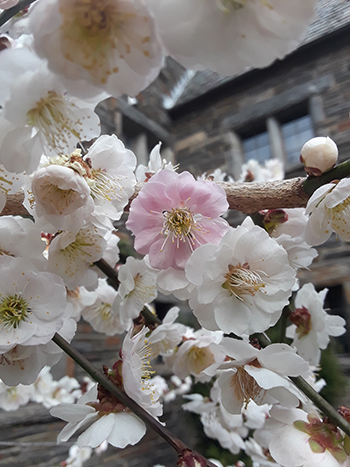
Plants of the Week: March 9

A welcome sight to beckon in spring each year are the blossoms of Prunus mume, commonly known as the Japanese apricot. This Asian prunus species, closely related to apricots and plums, is revered for its early flowering period which symbolizes the return of life.
Highly fragrant blossoms come in shades of white, pink and red, sometimes displaying multiple blossom colors on one plant. The five-petaled flowers occur singly or doubly on the previous years growth. Plants begin to flower in the winter months, opening in January through early March here in Southeast Pennsylvania, and boast an impressive flowering duration of four to eight weeks. Cut stems can be easily forced into flowering in a vase; harvest while flower buds are swollen but unopened.
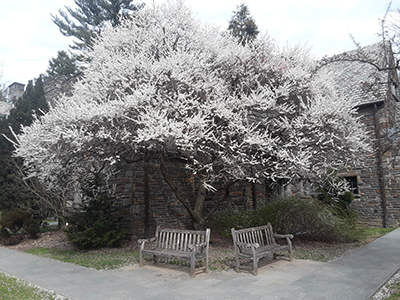
This lovely tree is small in stature, and can easily fit into most gardens. It is well-utilized in a border, in a grouping, or as a single specimen. A sunny location and well-drained acid soil is preferred. Many Prunus mume plants can be found blooming throughout the arboretum presently, with an especially gorgeous white flowered specimen nested into the corner of Bond Hall Courtyard. photo credit: R. Payne-Meyer
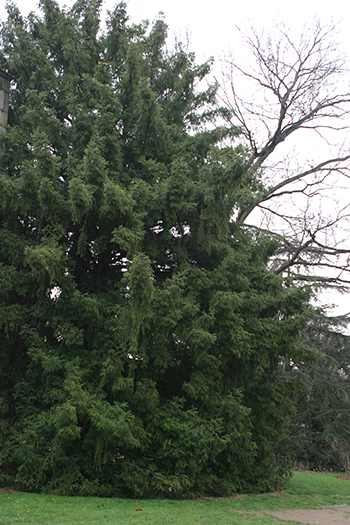
Flanking the Southwest corner of Clothier Hall is an enormous specimen of Torreya nucifera, the Japanese torreya. This slow-growing conifer of the yew family (Taxaceae) closely resembles plants of the Taxus genus, but can easily be differentiated by its prickly foliage, which sharply contrasts the soft, flexible needles of Taxus. Needles are long, stiff, flattened along the stem, and glossy dark green.
While the typical size of Torreya nucifera is around 15-30 feet tall, and 15 feet wide, a notable specimen at the Scott Arboretum was last measured at 43 feet tall by 32 feet wide. The large size of this tree is no surprise, as this tree was planted in 1929, the same year of the founding of the Arboretum. I was completely floored when I first set eyes on this behemoth, and I am not alone; Michael Dirr makes mention of our “great and noble” specimen in Dirr’s Encyclopedia of Trees and Shrubs and exclusive grower Broken Arrow Nursery notes our “outstanding specimen” in their catalogue.
Plants produce very large ovular seeds which resemble olive fruits and offer additional interest. This rare conifer can be effectively used as a screen, hedge, or specimen tree. In a season marked by bright colors, this dark green conifer still stands out as in unsurpassable specimen. photo credit: Diane Mattis
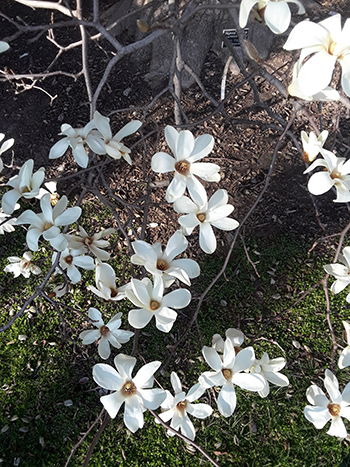
Another exciting plant dear to us at the Scott Arboretum is Magnolia denudata ‘Swarthmore Sentinel’, an extraordinary Scott Arboretum introduction of the Yulan magnolia. In contrast to the typical low, rounded shape of M. denudata, ‘Swarthmore Sentinel’, was selected for its unique upright growth form. The original specimen of this Yulan magnolia cultivar is beautifully ensconced on the Southwest corner of Bond Memorial Hall.
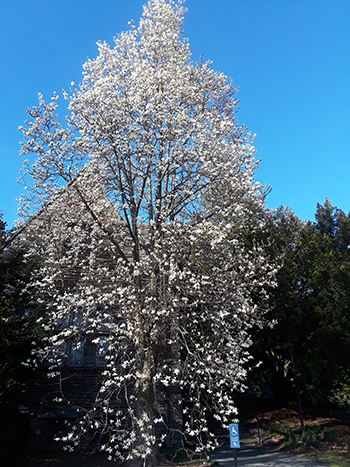
Given our uniquely mild winter, the warm weather of last week, and its south facing location, this tree is already opening its creamy white blooms. M. denudata is known for its early flowering period and susceptibility to browning if subjected to frost, so we can only hope the pleasant weather continues. Flowers offer a pleasant lemony scent, and are oriented in an attractive upright position, matching the cultivar’s growth habit. This lovely ornamental tree is well suited for tight spaces due to its fastigiate form, and is a great specimen tree in the landscape. photo credit: R. Payne-Meyer

Also situated near the aforementioned ‘Swarthmore Sentinel’ specimen is a Cornus mas ‘Spring Glow’ tree bursting with yellow blooms that absolutely cannot be ignored. This tree has been blooming beautifully for a number of weeks now, and is easily seen from Route 320. While the Swarthmore campus is closed to visitor until Sunday, April 5, you can follow us through the Garden Seeds blog, Facebook, and Instagram for great spring updates. photo credit: R. Robert





Wendy C
Posted at 09:03h, 19 MarchSo lovely to see cheerful blooms in these troubled times! Thank you!